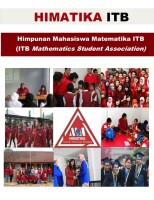Risma Yanti Review of Community Developement HMM ITB
The time period of the history of the establishmen...
The time period of the history of the establishment of ITB can be divided into periods:
Technische Hoogeschool te Bandoeng (THS - 1920-1942)
Institute of Tropical Scientific Research (1942-1945)
Bandoeng Koogyo Daigaku (1944-1945)
Bandung Technical College (1945-1946)
Technische Faculteit, Nood-Universiteit van Nederlandsch Indie (1946-1947)
Faculteit van Technische Wetenschap and Faculties of the Exact Wetenschap Universiteit van Indonesie te Bandoeng (1947-1950)
Faculty of Engineering and Faculty of Science and Natural Sciences, University of Indonesia Bandung (1950-1959)
Bandung Institute of Technology (1959-present)
The history of the Bandung Institute of Technology (ITB) dates back to the beginning of the 20th century, at the initiative of the ruling community at that time. The initial aim of its establishment was to meet the needs of technical personnel which had become difficult due to the disruption of relations between the Netherlands and its colonies in the archipelago, as a result of the outbreak of the First World War. Technische Hoogeschool te Bandoeng (often abbreviated as TH te Bandoeng, TH Bandung, or THS) was established on July 3, 1920 as the first high school in the Dutch East Indies. [Note 6] TH Bandung was opened for the first time with a faculty namely de Faculteit van Technische Wetenschap only has one part, namely de afdeeling der Weg-en Waterbouwkunde. The ITB campus is a place where the first Indonesian president, Soekarno, won his engineering degree in the field of Civil Engineering. The duration of study to become an engineer is four years. Until its closure in 1942, THS had three parts (afdeeling) namely Civil (1920), Chemistry (1940), Machinery and Electricity (1941) [note 7]; but the last two parts have not had the chance to pass an engineer.
During the Japanese occupation, efforts to reopen the TH Bandung lecture were rejected explicitly, but research activities in laboratories on the TH Bandung campus were permitted. The community laboratory is called the Institute of Tropical Scientific Research which is manned by many TH Bandung academic staff.
On April 1, 1944, THS was reopened by the Japanese Military Government under the name (Bandung K gy Daigaku) [17]: 26 after being closed since March 8, 1942 with the surrender of the Dutch East Indies in Kalijati. Bandoeng Koogyo Daigaku (BKD) opened three parts namely Civil Engineering (Dobubuka), Chemical Engineering (Oyakagabuka), Electricity and Machinery (Denki and Kikaika). The length of study to become an engineer (kogakusi) is three years, following the curriculum applied at Tokyo Kogyo Daigaku (Tokyo Institute of Technology) at that time.
Then at the time of Indonesian independence, in August 1945, the name was changed to the Bandung Technical High School (STT Bandung) which opened three parts namely the Road and Water Building Section, the Chemical Section, and the Machinery and Electricity Section with a four year study period. In 1946, STT Bandung was moved to Yogyakarta but due to the invasion of the Dutch army to Yogyakarta, on December 19, 1948 STT Bandung in Yogyakarta was forced to close. Some time later the school was reopened in 1949 with only holding the Civil Section and becoming the forerunner to the birth of the Faculty of Engineering, Gadjah Mada University.
On January 21, 1946, NICA established Nood-Universiteit van Nederlandsch Indie - Dutch East Indies Emergency University where one of its faculties was Technische Faculteit - Faculty of Engineering - as a substitute for STT Bandung at the THS Campus location. Most of the instructors were former THS teachers who had just been released from Japanese internment camps [5]: 14.
On March 12, 1947, NICA established Universiteit van Indonesie based in Jakarta. The THS campus and its instructors were used as Faculteit van Technische Wetenschap. On October 6, 1947, Faculteit van Exacte Wetenschap stood up.
This later became the Faculty of Engineering and the Faculty of Science and Natural Sciences of the University of Indonesia in Bandung since February 2, 1950.
On

Comments: